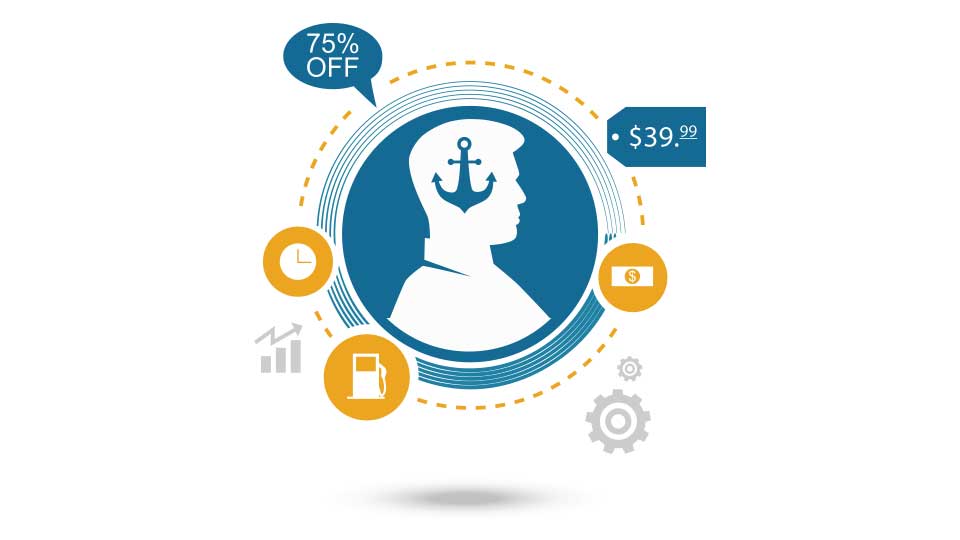4 psychological biases that marketers need to care about
One of the most influential "influences" to marketing is the power of psychology.
In recent years, neuroscientists have changed their outlook on marketing, customer access and business management. At the same time, he affirmed that a deeper understanding of the human brain will strongly impact the success of marketing campaigns.
A very broad aspect of psychology is that of solving cognitive bias problems. A cognitive bias means "a thinking mistake occurs when people handle and explain information about the living world."
Anyone can get these biases. This happens not because they are not intelligent or have limited cognition but simply because the brain emits electrical signals in many ways that are difficult to predict.
Here are four cognitive biases that vendors and marketers need to pay attention to.
1. The worry of loss (Loss Aversion)
Loss Averson is cognitive bias that makes people tend to avoid risks more than trying to achieve something. For example, if you lose 50 USD, a person will have a stronger feeling than receive the same amount. This mental phenomenon and its consequences - including prejudice about the current status (status quo bias) and the effect of the endowment effect will make us more interested in the things we already own. than.

Endownment is the term used to describe a common phenomenon that people often assign a higher value to things they already own than those they have not yet purchased. In other words, people often refuse to sell what they already own at a higher price than they are willing to spend at first. The result is a higher selling price for the item. For example, what price are you willing to sell your motorbike with? Do you think this price is higher or lower than the market price? Does anyone want to buy at that price or not? Part of this is the transaction cost issue. For example, selling a motorbike also takes time and effort, so it is easier to keep a car than to sell it to buy another car.
The bias quo status indicates the error that investors should act on but they don't do anything. This deviation often comes to beginners when they are not clear about what they are investing, it is unclear what risks they are, how to diversify, and not update market trends and industries. Potential career coming. Only when they really fail or lose will they begin to wake up.
In marketing, you should show customers that products or services are so great that they will feel lost if they do not act (buy). Then promote these messages on your landing page or company website, thereby turning ordinary Internet users into lead (potential customers).
2. Psychological "anchor" effect (Anchoring bias)
This happens when certain irrelevant information dominates your thought process.

People tend to take the first information heard or found to be the standard to evaluate the information they receive later. For example, when you go through a fashion store and see the price of a sweater is 500,000 VND, then continue to go to the store next door and see the same type of sweater for only half the price, immediately ie you will think the second shirt has a good price. At this point, your decision has been affected by the price of the first shirt.
The effect is "stuck" to something that has a greater impact on the price perception of an item. When the mind has been "anchored" we cannot be wise enough to recognize other more important factors. If we start with a huge number and then replace it with a very small number, users will feel that price is not expensive!
Marketers can apply this perceptions of customers to perform some tricks to increase their purchasing capabilities, such as reducing inventory prices, limit sales, or other ways to focus. Customer attention on the first elements that they care about. For example, a customer who buys a car when he has focused on the leather material of the seat will only care about the interior in the car but forget about other factors such as engine, kilometers or gas-saving kit .
3. Choice bias (Choice-supportive bias)
When you choose something, you tend to feel positive about it, even if your choices make mistakes. You think your dog is great - even if it occasionally bites other people - and other dogs are stupid because they're not your dogs.

We all have priorities for unknown reasons, such as liking a type of cosmetics, phone lines, music, food or views about a social issue . Accordingly, we only focus on their positives and don't mind too much on the negative side.
For example, when you are a fan of a team, many people tend to mitigate bad things like losses, inferior players or problematic management teams. Instead, they praised the stars in the team, the gold medals, the championship in history or the beautiful phase made by some members of that team.
This prejudice will impact marketing activities in the following ways:
- Customers tend to buy products / services they find familiar.
- Customers tend to trust information that supports their choice.
- Customers tend to forget information against their views.
The effect for this choice is effective when the customer has purchased the product. By using email marketing, the company can increase customer awareness of the brand by sharing comments (testimonial), evidence of product superiority and reminding about why They have chosen products.
Marketers can also create this bias effect before customers buy products by email opt-in method (form of sending email after being allowed by customers), "like" button on social networks, thereby making them unconscious decisions and quickly becoming customers.
4. Effects due to presentation (Framing bias)
Expression effect is one of the most popular psychological effects in marketing. Accordingly, each person's decision will depend on how the choices are presented.

An experiment on the expression effect made by two economists Kahneman and Tversky raised a problem with two options:
- Option 1: 33% chance to save 600 people, but there is 66% chance no one is saved. Results: 200 lives saved.
- Option 2: there is a 33% chance no one has to die, but there is a 66% chance that everyone must die. Result: 400 people will die.
The two options have identical results, but are expressed in two different ways, one is positive, and the other is negative. Most of the survey participants chose a positive expression.
As can be seen, a change in presentation has made differences
A few more examples of changes in word usage can create this effect:
- Global warming - Climate change.
- Save 50% - Cut in half.
- You won - She lost.
- 30% full - Empty 70%.
- No military experience - Deep political experience.
- 90% chance of survival - 10% risk of death.
This interesting effect is widely used by politicians, entrepreneurs, parents and all those who stand in the middle of the role to shape people's reactions to information. The truth is still true, but the way you say it will affect the way people react to them.
Conclusion
- The worry of loss will make customers cling to what they already own.
- The "anchor" effect will keep customers focused on the first information they receive.
- The bias in choice means that customers will feel comfortable with something familiar to them and ignore conflicting evidence.
- Expressions will affect the negative or positive perception of customers about products, services or events.
The above mentioned prejudices exist in all customers at different levels. You just need to detect and apply them properly to help customers make the right decision.
You should read it
- Want to become a 'master' on sale, you must know 5 styles of sales!
- 10 effective sales techniques everyone needs to know
- 10 miraculous colors that can boost sales
- 6 Powerful Sales Techniques Even Non-Salespeople Should Master
- 9 great 'pickpockets' customers that clothing salespeople never reveal to you
- Pokemon Go suggests 3 important Insight on sales and marketing
 Halo effects and advantages of attractive people
Halo effects and advantages of attractive people 12 habits of successful people early in the morning to the office
12 habits of successful people early in the morning to the office Why is working 4 days a week harmful to health?
Why is working 4 days a week harmful to health? 5 simple ways to maintain positive thinking
5 simple ways to maintain positive thinking 5 'sunk costs' of happiness
5 'sunk costs' of happiness 4 tips to help you ask smart questions
4 tips to help you ask smart questions